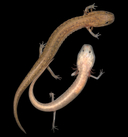|
Eurycea latitans Smith & Potter, 1946
Cascade Caverns Salamander Subgenus: Notiomolge | family: Plethodontidae subfamily: Hemidactyliinae genus: Eurycea |
 © 2019 Tom Devitt (1 of 5) |
|
|
Country distribution from AmphibiaWeb's database: United States
U.S. state distribution from AmphibiaWeb's database: Texas
Eurycea latitans Smith and Potter, 1946 Paul T. Chippindale1 1. Historical versus Current Distribution. Cascade Caverns salamanders (Eurycea latitans) were first described by Smith and Potter (1946) from Cascade Caverns, Kendall County, Texas. Brown (B.C., 1967a) provided a review of what was known about this species at that time. Sweet (1978a, 1984) demonstrated that this population includes individuals with a spectrum of morphological features, ranging from highly cave-associated morphologies most similar to those of Comal blind salamanders (E. tridentifera), to surface-like morphologies most similar to those of what he considered Texas Salamanders (E. neotenes). He hypothesized that this was the result of hybridization between a surface population of Texas salamanders and a population of the cave-dwelling Comal blind salamanders. Most recent authors have not recognized Cascade Caverns salamanders as a distinct species. Chippindale et al. (2000) found no evidence that salamanders from the Cascade Caverns system are hybrids. Based on molecular data, the Cascade Caverns salamander population appears most closely related to many other cave and spring populations in the southeastern Edwards Plateau region that do not include the type localities of either Texas salamanders or Comal blind salamanders. Chippindale (2000) and Chippindale et al. (2000) provisionally recognized the E. latitans complex, in which they included the population at the type locality, plus many others from Comal, Kendall, and eastern Kerr counties. Relationships among members of this group, and their relationships to other southeastern Edwards Plateau Eurycea, remain to be studied in more detail. 2. Historical versus Current Abundance. As with many cave-dwelling populations of Texas Eurycea, it is difficult to assess population sizes. The most recent collection of topotypes of this species of which I am aware was in 1992, when P. Chippindale, A. Grubbs, and J. Hunter obtained five specimens from Pfeiffer's Water Cave, a subterranean extension of Cascade Caverns. Sweet (1978a, 1984) documented an apparent shift in phenotypes at the type locality, from predominance of individuals with cave-associated morphologies to predominance of individuals with surface-associated morphologies, over a period of several decades. Members of the E. latitans complex (as broadly recognized by Chippindale et al., 2000) often are common at spring outflows, but their distribution appears to be limited and patchy. 3. Life History Features. A. Breeding. Reproduction is aquatic. i. Breeding migrations. Unlikely to occur. ii. Breeding habitat. Unknown within their cave ecosystem. B. Eggs. i. Egg deposition sites. Unknown; closely related species are thought to deposit eggs in gravel substrate. ii. Clutch size. Unknown. C. Larvae/Metamorphosis. Cascade Caverns salamanders are paedomorphic, and natural metamorphosis is unknown. Features of larval life are also unknown. D. Juvenile Habitat. Probably similar to adult habitat. E. Adult Habitat. Completely aquatic. Known only from caves that contain water and the immediate vicinity of spring outflows; individuals in caves are often seen in the open on submerged rock or mud substrate, whereas individuals from spring populations are found under rocks and leaves and in gravel substrate. Water temperature in springs and caves of the Edwards Plateau is relatively constant throughout the year and typically ranges from 18–20 ˚C or slightly warmer near the fault zone at the Plateau's edge (Sweet, 1982). Sweet (1982) provided a comprehensive distributional analysis of the central Texas Eurycea and discussed hydrogeology of the region in relation to salamander distribution. F. Home Range Size. Unknown. G. Territories. Unknown. H. Aestivation/Avoiding Dessication. Aestivation is unknown. I. Seasonal Migrations. Unlikely. J. Torpor (Hibernation). Probably active throughout the year. K. Interspecific Associations/Exclusions. As described in "Historical versus Current Abundance" above, Sweet (1978a, 1984) considered the population at the type locality to be hybrids between E. neotenes and E. tridentifera. Chippindale (1995) and Chippindale et al. (2000) regarded this as unlikely based on molecular data and continued to recognize E. latitans as a distinct species. Sweet (1978a, 1984) noted that members of this species complex (most of which he considered E. neotenes) are usually absent from caves in which fishes occur. L. Age/Size at Reproductive Maturity. In a morphometric analysis of some Edwards Plateau Eurycea (Chippindale et al., 1993), average SVL of the Cibolo Creek Spring population (which Chippindale et al. [2000] later included in the E. latitans complex) that were presumed to be adult was 33.8 mm. However, Chippindale et al. (2000) probably did not include the smallest reproductively mature specimens in their analysis, and no rigorous studies of reproductive biology have been conducted for this species. Barden and Kezer (1944) described eggs and egg deposition by a captive individual from a population that is likely (based on geographic location) to be part of this species complex. M. Longevity. Unknown. N. Feeding Behavior. Prey probably consists mainly of small aquatic invertebrates, but no detailed feeding studies of this species have been conducted. O. Predators. Unknown. P. Anti-Predator Mechanisms. Individuals from spring populations are secretive. Sweet (1978a, 1984) noted that individuals from the type locality (Cascade Caverns) show escape behaviors similar to those of animals from surface springs (i.e., movement toward substrate and cover items). Q. Diseases. Unknown. R. Parasites. Unknown. 4. Conservation. As with many cave-dwelling populations of Texas Eurycea, it is difficult to assess population sizes of Cascade Caverns salamanders. Cascade Caverns salamanders can be common at spring outflows, but their distribution appears to be limited and patchy. They are listed as Threatened in Texas, but have no special recognition by the Federal Government. 1Paul T. Chippindale Literature references for Amphibian Declines: The Conservation Status of United States Species, edited by Michael Lannoo, are here. Feedback or comments about this page.
Citation: AmphibiaWeb. 2024. <https://amphibiaweb.org> University of California, Berkeley, CA, USA. Accessed 24 Nov 2024. AmphibiaWeb's policy on data use. |



 Raffaëlli Account
Raffaëlli Account Map of Life
Map of Life